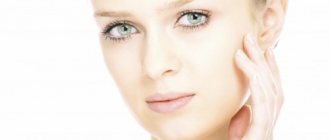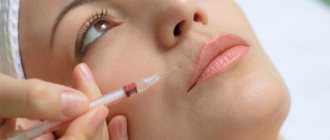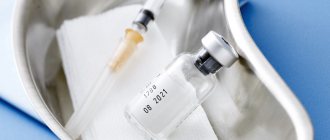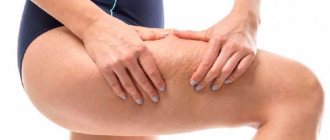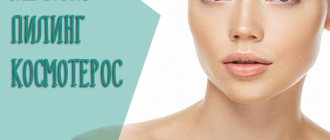Many women take pregnancy quite seriously, for this reason they try not to use harmful foods in their diet, and they also do not dye their hair with harmful dyes. But it is during pregnancy that changes occur in the body; hormones can affect not only the emotional state, but also the appearance of the skin on the face; for this reason, the condition of the skin during pregnancy can change greatly.
As a result of the restructuring of the body during pregnancy, girls often develop pimples and rashes on their face, which every expectant mother would like to remove without harming the baby. It is in this case that the question arises about whether it is possible to do peeling during pregnancy, as well as what types of peelings are allowed for use at such a time. As experienced specialists say, some types of skin cleansing can be used even “in position,” but they are done only after consultation with a gynecologist, as well as on the recommendation of an experienced cosmetologist.
In what cases is facial peeling recommended for an expectant mother?
Peeling during pregnancy is carried out only for certain indications, for this reason it is worth knowing for what reasons a woman can use such a procedure to cleanse her facial skin. The first thing worth mentioning is the signs of vitamin deficiency, also if inflammatory processes and rashes occur on the surface of the skin, in some cases the skin reacts negatively to ultraviolet rays and cosmetics, in this case peeling will help eliminate the consequences of the reaction.
But this is not all the indications, because the procedure is approved for dry skin, especially when small cracks begin to appear on the face and become inflamed. The skin may peel off, and inflammation will increasingly appear around the lips.
Benefits of retinoic peeling for skin
Retinoic peeling is valued by cosmetologists and self-care lovers for its versatility and short recovery period after procedures. A couple of sessions of “yellow” exfoliation simultaneously eliminates several diverse appearance defects: from acne to hyperpigmentation. The safety and gentleness of retinoic cleansing in case of mild aesthetic problems allows you to perform the beauty procedure even in summer.
The peeling is called “yellow” because of the color of the main active ingredient – retinol. The chemical group of retinoids includes natural vitamin A and its artificially created structural analogues. Retinoids in complex peelings carefully interact with the skin, destroying and exfoliating dense keratosis, but without affecting living tissue. Therefore, retinoic peeling is a type of borderline, or superficial-median procedure.
Unlike other medium peels, retinol-based exfoliation is characterized by minor damage to the integrity of the skin, which means a minimal risk of complications and quick recovery. Retinol, being integrated into intercellular structures, helps tighten the skin framework and deeply renew it. Therefore, a week after the “yellow” session, many women notice that the depth of wrinkles has become smaller, the skin is lighter, and inflammation has decreased or disappeared completely.
The tightening, antiseptic and whitening effect of the yellow film of retinoic peeling has a prolonged effect and lasts for approximately 3 to 4 months. Then the course of procedures can be repeated and the supply of vitamins and antioxidants in the epidermal cells can be replenished.
Most often, retinol-based peeling is recommended for:
- dull complexion and hyperkeratosis - a dense “crust” of keratinized cells on the surface of the skin;
- “black dots” (comedones) on the face;
- milia – “white” acne;
- shallow expression lines and first age wrinkles;
- signs of skin photoaging;
- dry skin (reduced production of the skin’s own hyaluronic acid);
- loss of elasticity (lack of collagen threads in the skin);
- the appearance of light brown pigment spots.
Women can take advantage of the miraculous benefits of retinoic peeling from the age of 35. But express rejuvenation with retinol is not available to everyone. One of the first contraindications on the list of prohibitions for yellow exfoliation is pregnancy and planning to conceive. The controversy surrounding how natural or synthesized retinol obtained by the skin from peeling compounds affects the normal formation of the fetus is still relevant. In order to understand the possible cause of concern and decide when it is better to get pregnant after yellow peeling, you need to remember the chemical properties of retinoids and their role in the body.
Several Important Factors
During pregnancy, a woman’s immunity naturally decreases, for this reason various allergic reactions that the woman has never experienced before may increasingly appear, then peeling will help eliminate unpleasant symptoms. When hormonal levels change, dark pigment spots may form on the skin, or inflammation and rashes may appear.
It is very important to remember that during pregnancy the body reacts to various factors differently; for this reason, women are recommended before peeling not only to consult a specialist, but also to conduct a special test for skin reaction.
If after several minutes of keeping the mixture on the skin, no negative reaction occurs, we can say with confidence that the procedure is safe for the health of the expectant mother.
Facial peeling during pregnancy is carried out exclusively with the help of certain mixtures, but without the use of devices that affect the skin with invisible rays. Such peeling during pregnancy may have a minimal effect on the skin, but it will negatively affect the health of the fetus and the expectant mother; for this reason, it is better to avoid using hardware procedures. Some women prefer to use an ultrasonic cleansing procedure or light current, but this method is strictly prohibited during pregnancy.
It is important to remember that there are certain substances that do not pose any harm to a woman’s health, since they are applied to the skin in a very thin layer, but it is for the fetus that such a composition can become quite dangerous. Even if your pregnancy is still very short, it is worth informing your cosmetologist about your “interesting situation” so that an experienced specialist can choose the right method for cleansing your skin.
In any case, peeling during pregnancy can be stressful for the body, for this reason it would be better to check the expiration dates of the formulations used, as well as check the availability of certificates for the materials used. Not only high-quality chemicals and cosmetics are important, but also the cleanliness of the equipment used; all instruments must be disposable and sterile.
Ready-made peeling compositions are strictly prohibited for use during pregnancy; they contain a large number of dyes and chemical additives, which will certainly have a negative impact on the development of the fetus. In addition, such compositions not only will not have the correct effect on the skin, but can also cause deterioration of the skin condition, as harmful toxins penetrate into the tissues. As experienced specialists say, during the period of bearing a baby, as well as during breastfeeding, it would be better to abolish any aggressive methods of cleansing the skin; it is safer to give preference to mild and simple chemical peels during pregnancy.
How long after the procedure can you not become pregnant?
A course consisting of 4–6 peeling sessions using products containing retinol forms a vitamin reserve in the skin; it lasts for about 3 months.
During this time, the epidermis will contain retinoic acid molecules, which promote visual rejuvenation.
The effect of yellow peeling lasts longer than other procedures aimed at skin rejuvenation that have a superficial effect.
For a normal pregnancy after yellow peeling, at least three months must pass before the planned conception.
If a woman is going to get pregnant and soon become a mother, she should refrain from retinoic exfoliation and replace the procedure with another one, for example, multi-fruit or milk peeling.
We recommend: How to get rid of age spots using peeling in the salon and at home? Precautions and expert advice
What peelings are safe to do during pregnancy?
A pregnant woman can undergo various types of peelings; now we will consider a possible list of those procedures that are performed only in salons, but it is worth remembering that using chemicals at home is dangerous, especially during the period of pregnancy.
Almond peeling . This procedure is an excellent gentle remedy that improves the condition of the skin, helps remove old skin flakes, cleansing the epidermis. In addition, the acid contains useful components that nourish the skin with essential substances. With this procedure, a woman can whiten her skin, eliminating age spots and redness; the method also allows you to remove acne and eliminate comedones. Mandelic acid is often used for mild skin inflammation, as it has an antibacterial and anti-inflammatory effect, drying out small pimples and eliminating them from the skin. This substance helps remove all harmful substances, toxins and waste from the skin of the face, which not only improves the condition of the skin, but also makes the appearance healthier and fresher.
Milk peeling . This procedure is based on lactic acid, the method is also quite easy and gentle, the acid penetrates only into the upper layers of the skin, which allows it to accelerate the production of collagen, as well as moisturize the skin and restore the protective functions of the skin. This cleaning method is especially relevant for women suffering from dry and flaky skin, while the skin will not be damaged, since the acid substances are very small and easily penetrate the skin cells.
Glycolic peeling . This option is suitable for those ladies who, during pregnancy, experienced the appearance of age spots on their dark-colored faces; peeling helps to lighten the spots, as well as generally even out the color of the skin on their face. Also, this method of cleansing makes it possible to make the relief of the skin more even and smooth, but it is worth remembering that such a procedure during pregnancy is carried out only by the superficial method.
Apple peeling . Some women prefer to carry out this procedure at home, but it is still better to contact an experienced specialist; the composition helps saturate the skin with all the necessary microelements and vitamins. After cleansing, a woman will be able to notice that the skin has become smoother and softer, and the composition is also an excellent anti-inflammatory and antibacterial agent, therefore it destroys pathogenic bacteria on the surface of the skin.
Azelaine peeling . It is this procedure that can solve a very large number of some skin problems that bother a pregnant woman. For example, there are problems for which peelings are generally contraindicated, but the azelaine composition makes it possible to fight severe manifestations of acne, and cleansing with this method also helps with rosacea and rosacea. To enhance the effect of the composition, some cosmetologists prefer to add a little lactic or mandelic acid to the preparation, this helps make the composition stronger in terms of antibacterial and anti-inflammatory effects.
Wine peeling . Tartaric acid is not often used in cosmetology, but during pregnancy, women are often offered to try this procedure on themselves. The composition gently cleanses the skin, making the skin softer and more delicate, in addition, you can notice that the skin tone has increased significantly. After several procedures, it becomes noticeable that small stretch marks on the face begin to disappear, and stretching of the skin often occurs under the pressure of hormones and weight changes.
Gas-liquid peeling. Today, this is the only procedure that is not prohibited during pregnancy; nevertheless, some cosmetologists warn expectant mothers that the skin may react in an undesirable way to this cleansing method. It is in this procedure that only oxygen and water are used; other drugs and preparations are strictly prohibited.
Phytin peeling. This cleansing method does not require any preliminary preparation of the skin from the woman, and the skin does not have to recover after cleansing. The composition helps eliminate rosacea; in addition, it gets only into the upper layers of the skin, helping to whiten age spots and eliminate enlarged pores. Still, cosmetologists say that this cleaning method is used during pregnancy with great caution.
§3. Benzoyl peroxide, salicylic acid and acne prevention during pregnancy.
Many of our patients ask about benzoyl peroxide or salicylic acid.
Benzoyl peroxide is a class C substance that poses no particular threat to both humans and animals. However, it can enter the body through the skin. Cosmetologists and doctors do not recommend using benzoyl peroxide during pregnancy.
Other topical acne medications include erythromycin or clindamycin (both class B), or azealic acid (class B) to treat acne, redheads, and hyperpigmentation during pregnancy. Azealic acid is sold under the brand name Finacea. Before using this medication, you should consult your doctor and see the description of the categories below.
Salicylic acid belongs to class “C”. It is a metabolite of aspirin that is classified as "D" and can be absorbed through the skin. Studies of this drug have not yet been carried out on humans, however, animal studies have shown that salicylic acid can pose a danger with systematic use of large doses - complications during childbirth and defects in newborns. It is best to stop taking this drug to protect the fetus during pregnancy.
A new solution for treating acne during pregnancy is ultraviolet light.
A relatively new method of combating acne is ultraviolet treatment. Dermatologists usually suggest applying a cleansing lotion before starting the procedure. During the procedure, ultraviolet light is directed onto the skin. The lotion is aminolevulinic acid. Most pregnant women refuse to use lotion before ultraviolet treatment.
This treatment means that you will have to be under the light of ultraviolet lamps for 15 minutes twice a week. Natural blue light kills bacteria that causes acne. This is a completely natural treatment method that is 100% safe for pregnancy and breastfeeding.
Some salons offer this service called BLU-U Acne Treatment or Ultraviolet Treatment. See also everything you wanted to know about acne and how to treat it.
What about melasma during pregnancy and hydroquinones?
Hydroquinones belong to class “C”. There is no data on its use during pregnancy, but doctors do not recommend its use. For melasma during pregnancy, it is recommended to wear caps with a large visor, as well as use sunscreens that contain zinc or titanium (they eliminate the chemical effects of the sun on the skin), or, for example, azelaic acid (as prescribed by a doctor). Glycolic peels are safe to use during pregnancy, but may have a negative effect on melasma, depending on the age of the pregnant woman and how much time she spends in the sun.
Tretinoin (Renova, Retin A, etc.) belongs to class “C”, and there have been two cases where the mother developed complications after using tretinoin before and during the first trimester of pregnancy, but the exact effect on pregnancy has not been proven. Popular corticosteroids are generally considered safe for use during pregnancy and do not cause birth defects, as there have been no documented cases of popular steroids affecting pregnant women.
Is it possible to do home peeling?
It is best to use various natural types of scrubs; formulations based on some softer abrasive substances or herbal decoctions would be an excellent option. One of the herbal decoctions with ground tea leaves from which tea has already been brewed is perfect.
In this case, the abrasive will be quite soft, but will clean the skin well. It is important to remember that the use of dense and hard particles is strictly prohibited, so as not to aggravate the situation. Gommages made from the juice of berries or fruits are perfect, but it is worth remembering that during pregnancy the body may reject certain fresh berries or fruits, so you need to listen to how you feel.
What types of peelings are prohibited during pregnancy?
It is worth saying that hardware procedures are strictly prohibited during the period of bearing a baby, but there are some types of chemical peels that also cannot be used in an “interesting position.” For example, the use of salicylic acid is strictly prohibited, as it negatively affects the health and development of the fetus; you should also avoid using retinoic or phenolic acid.
It would be better to refuse even simple manual facial cleansing, although it effectively eliminates some problems, but still the risk of bacterial infection is too great during the period of gestation.
What are the contraindications?
One of the main restrictions on retinoic peeling is pregnancy, but there are a number of other prohibitions that are best familiarized with in advance. It is not recommended to carry out the procedure in the following cases:
- pathologies of the liver, kidneys;
- individual reaction of the body to some components of the drug;
- treatment with pharmaceutical products based on retinoids;
- diseases of the dermis at the peak of exacerbation;
- external use of retinol derivatives - an excess of the substance can lead to a hyperreaction;
- skin sensitive to aggressive procedures;
- inflammatory processes on the face;
- hyperpigmentation.
